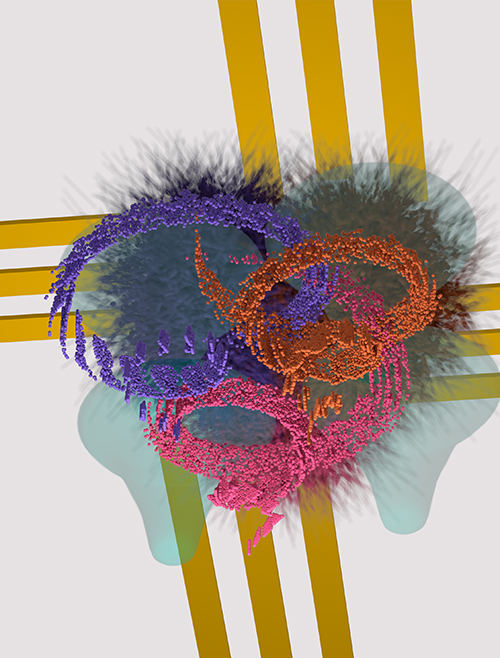The magnet that didn’t exist
In 1966, Japanese physicist Yosuke Nagaoka predicted the existence of a rather striking phenomenon: Nagaoka’s ferromagnetism. His rigorous theory explains how materials can become magnetic, with one caveat: the specific conditions he described do not arise naturally in any material. Researchers from QuTech, a collaboration between TU Delft and TNO, have now observed experimental signatures of Nagaoka ferromagnetism using an engineered quantum system. The results were published today in Nature.
Familiar magnets such as the ones on your refrigerator are an everyday example of a phenomenon called ferromagnetism. Each electron has a property called ‘spin’, which causes it to behave like a miniscule magnet itself. In a ferromagnet, the spins of many electrons align, combining into one large magnetic field. This seems like a simple concept, but Nagaoka predicted a novel and surprising mechanism by which ferromagnetism could occur – one that had not been observed in any system before.
Child’s puzzle
“To understand Nagaoka’s prediction, picture the simple mechanical children’s game called the sliding puzzle,” said JP Dehollain, who performed the experiments together with Uditendu Mukhopadhyay. “This puzzle consists of a four-by-four grid of tiles, with a single empty slot to allow the tiles to slide around to solve the puzzle. Next, think of the Nagaoka magnet as a similar two-dimensional square lattice, where each tile is an electron. The electrons then behave like the tiles in the children’s game, shuffling around in the lattice.”
The child’s puzzle can be used to explain Nagaoka ferromagnetism. The puzzle on the left shows that every shuffle changes the spin configuration. The puzzle on the right shows all the spins aligned, which lowers the energy of the system.
If the electron spins are not aligned (i.e. each tile has an arrow pointing in a different direction in our analogy) then the electrons will form a different arrangement after every shuffle. In contrast, if all the electrons are aligned (all the tiles have arrows pointing in the same direction), the puzzle always stays the same, no matter how the electrons are shuffled. “Nagaoka found that alignment of electron spins results in a lower energy of the system,” Dehollain said. “As a consequence, the system of a square 2D lattice which has one missing electron will naturally prefer to be in a state in which all electron spins are aligned – a Nagaoka ferromagnetic state.”
DIY magnet
The researchers observed, for the first time ever, experimental signatures of Nagaoka ferromagnetism. Mukhopadhyay: “We achieved this by engineering an electronic device with the capability to ‘trap’ single electrons. These so-called quantum dot devices have been used in science experiments for a while now, but our challenge was to make a 2D lattice of four quantum dots that is highly controllable. To make these devices work, we need to build an electric circuit at a nanometre scale, cool it down to nearly absolute zero (-272.99°C), and measure tiny electrical signals.”
"Our next step was to trap three electrons and allow them to move around within the two-by-two lattice, creating the specific conditions required for Nagaoka ferromagnetism,” said Mukhopadhyay. “We then had to demonstrate that this lattice indeed behaves like a magnet. The magnetic field generated by three electrons is too small to detect with conventional methods, so instead we used a very sensitive electric sensor which could ‘decipher’ the spin orientation of the electrons and convert it into an electrical signal that we could measure in the lab. In this way we were able to determine whether or not the electron spins were aligned as expected.”
Artist impression of Nagaoka ferromagnetism on the 2x2 lattice of quantum dots.
The puzzle solved
“The results were crystal clear: we demonstrated Nagaoka ferromagnetism,” said Lieven Vandersypen, lead investigator and co-director of the Kavli Institute of Nanoscience. “When we started working on this project, I wasn’t sure whether the experiment would be possible, because the physics is so different from anything else that we have ever studied in our lab. But our team managed to create the right experimental conditions for Nagaoka ferromagnetism, and we have demonstrated the robustness of the quantum dot system.”
While this small-scale system is far from having implications in everyday life, it is an important milestone towards realising larger-scale systems such as quantum computers and quantum simulators. Vandersypen: “Such systems permit the study of problems that are too complex to solve with today’s most advanced supercomputer, for example complex chemical processes. Proof-of-principle experiments, such as the realisation of Nagaoka ferromagnetism, provide important guidance towards developing quantum computers and simulators of the future.”
*****
Publication
Nagaoka ferromagnetism observed in a quantum dot plaquette
Juan P. Dehollain, Uditendu Mukhopadhyay, Vincent P. Michal, Yao Wang, Bernhard Wunsch, Christian Reichl, Werner Wegscheider, Mark S. Rudner, Eugene Demler, Lieven M. K. Vandersypen
Nature, available online 2 March 2020
DOI 10.1038/s41586-020-2051-0
Funding
This research was supported by the Dutch Research Council(FOM projectruimte and NWO Vici) and the European Research Council (ERC-Synergy).
Graphics
The animation is free to use, credit Scixel de Groot for QuTech.
The artist impression is free to use, credit Sofía Navarrete and María Mondragón De la Sierra for QuTech.


